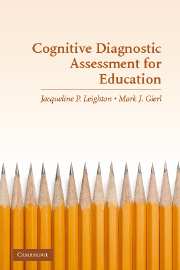Book contents
- Frontmatter
- Contents
- List of Contributors
- PART I THE BASIS OF COGNITIVE DIAGNOSTIC ASSESSMENT
- PART II PRINCIPLES OF TEST DESIGN AND ANALYSIS
- 5 Construct Validity and Cognitive Diagnostic Assessment
- 6 Verbal Reports as Data for Cognitive Diagnostic Assessment
- 7 Test Construction and Diagnostic Testing
- PART III PSYCHOMETRIC PROCEDURES AND APPLICATIONS
- Author Index
- Subject Index
- References
7 - Test Construction and Diagnostic Testing
Published online by Cambridge University Press: 23 November 2009
- Frontmatter
- Contents
- List of Contributors
- PART I THE BASIS OF COGNITIVE DIAGNOSTIC ASSESSMENT
- PART II PRINCIPLES OF TEST DESIGN AND ANALYSIS
- 5 Construct Validity and Cognitive Diagnostic Assessment
- 6 Verbal Reports as Data for Cognitive Diagnostic Assessment
- 7 Test Construction and Diagnostic Testing
- PART III PSYCHOMETRIC PROCEDURES AND APPLICATIONS
- Author Index
- Subject Index
- References
Summary
Among the many test uses listed in the Standards for Educational and Psychological Testing (American Educational Research Association, American Psychological Association, & National Council on Measurement in Education, 1999) diagnosis is perhaps the most complex. Assessment for diagnosis transforms quantitative data into rich qualitative descriptions of individuals' cognitive abilities, psychological pathologies, and personalities. The use of diagnostic tests has historically been applied to psychological assessment for psychiatric and neuropsychiatry diagnosis, with fewer examples of educational tests designed for this purpose. More commonly, educational testing has focused on purposes such as rating, selection, placement, competency, and outcome evaluation. Consequently, the test development procedures included in the majority of the educational assessment literature pertain to test construction for these purposes. Recently, however, educators have recognized educational assessments as missed opportunities to inform educational decisions. Nowhere is this realization more evident than in the No Child Left Behind (NCLB) Act of 2001 in the United States, specifically as it pertains to the development and use of yearly standardized achievement tests.
Such assessments shall produce individual student interpretive, descriptive, and diagnostic reports … that allow parents, teachers, and principals to understand and address the specific academic needs of students, and include information regarding achievement on academic assessments aligned with State academic achievement standards, and that are provided to parents, teachers, and principals as soon as is practicably possible after the assessment is given, in an understandable and uniform format, and to the extent practicable, in a language that parents can understand. (NCLB, Part A, Subpart 1, Sec. 2221[b]3[C][xii], 2001)
- Type
- Chapter
- Information
- Cognitive Diagnostic Assessment for EducationTheory and Applications, pp. 173 - 202Publisher: Cambridge University PressPrint publication year: 2007
References
- 17
- Cited by



